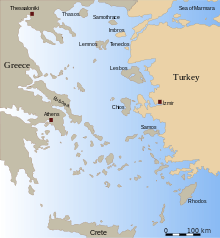Chryse (island)
Coordinates: 39°55′00″N 25°33′00″E / 39.916667°N 25.550000°E
Chryse (Greek: Χρύση, Khrýsē, "Golden") was a small island in the Aegean Sea mentioned by Homer, Sophocles and Pausanias.
The island's main feature was said to be its temple to Apollo, and its patron deity a goddess named Chryse. The Greek archer Philoctetes stopped there on his way to Troy and was fatally bitten by a viper. Lucullus captured three men there in an ambush during the Third Mithridatic War.[1] The island seems to have disappeared by the 2nd century AD; it is mentioned by Pausanias [2] and Appian.[3] An ancient oracle (written by Onomacritus) may have predicted this end.[4]
The Description of Greece says:
The following incident proves the might of Fortune to be greater and more marvellous than is shown by the disasters and prosperity of cities. No long sail from Lemnos was once an island Chryse, where, it is said, Philoctetes met with his accident from the water-snake. But the waves utterly overwhelmed it, and Chryse sank and disappeared in the depths... So temporary and utterly weak are the fortunes of men.— Pausanias, Description of Greece 8.33.4
An amateur underwater archaeologist claimed to have rediscovered the island in 1960, identifying it with "a sunken land mass known as Kharos Bank, a 10-sq.-mi. area near the island of Lemnos", listed on British naval charts and located about 40 feet (12 m) below the surface. White building blocks (presumably from Apollo's temple) were said to be visible on the sea floor.[5] The Kharos Bank is mentioned by others as a possible site, but there does not appear to have been further work on it.[6]
References
- ↑ Gillies, John (1820). "XXVII: From Alexander to Augustus". The history of ancient Greece: its colonies and conquests; from the earliest accounts till the division of the Macedonian empire in the East. Including the history of literature, philosophy, and the fine arts, Volume 4, Part 2. 4. T. Cadell and W. Davies. p. 249.
- ↑ 8.33.4
- ↑ Mithridat. c. 72 et seq.
- ↑ Javier Martínez, "Onomacritus the Forger, Hipparchus' Scapegoat?", in Fakes and Forgers of Classical Literature, Madrid, 2011, ISBN 84-7882-725-0, p. 225.
- ↑ "Philoctetes Was Here". TIME magazine. December 19, 1960.
- ↑ Harrison, S. J. (1 January 1989). "Sophocles and the Cult of Philoctetes". The Journal of Hellenic Studies. 109: 173–175. doi:10.2307/632045. JSTOR
